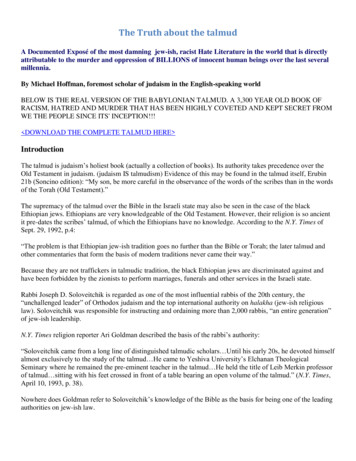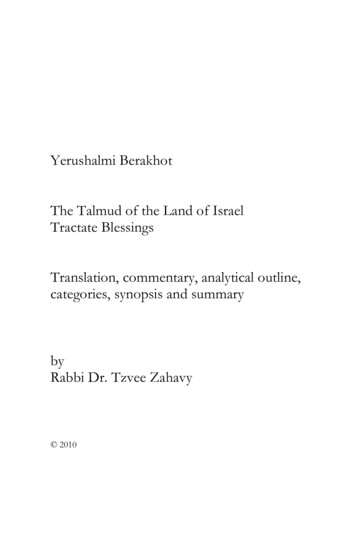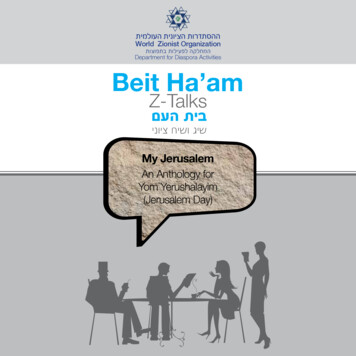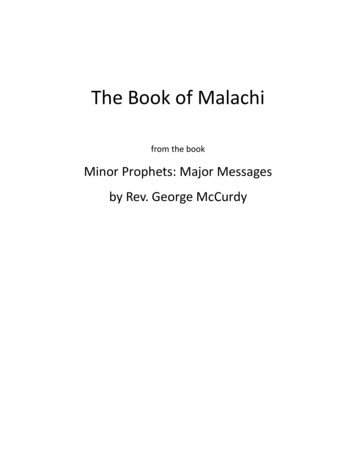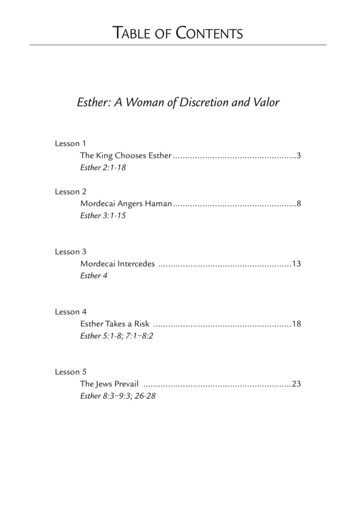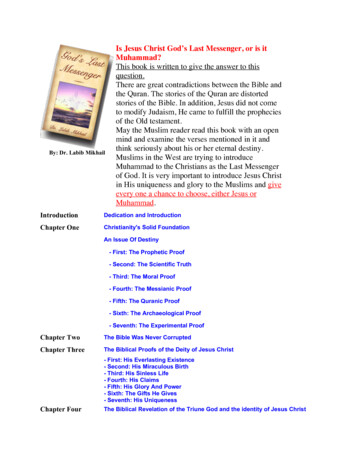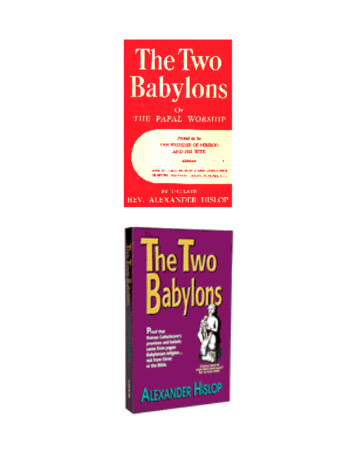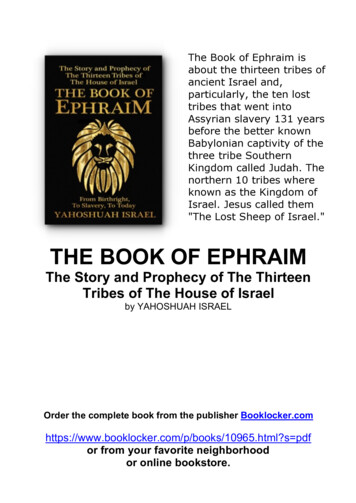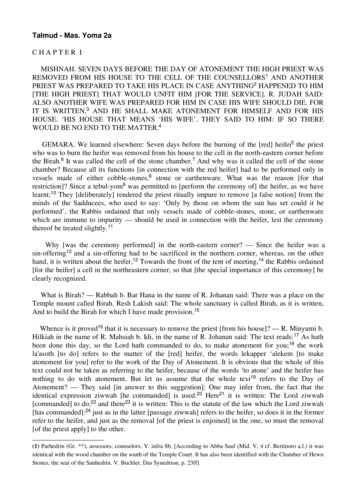
Transcription
Talmud - Mas. Yoma 2aCHAPTER IMISHNAH. SEVEN DAYS BEFORE THE DAY OF ATONEMENT THE HIGH PRIEST WASREMOVED FROM HIS HOUSE TO THE CELL OF THE COUNSELLORS1 AND ANOTHERPRIEST WAS PREPARED TO TAKE HIS PLACE IN CASE ANYTHING2 HAPPENED TO HIM[THE HIGH PRIEST] THAT WOULD UNFIT HIM [FOR THE SERVICE]. R. JUDAH SAID:ALSO ANOTHER WIFE WAS PREPARED FOR HIM IN CASE HIS WIFE SHOULD DIE. FORIT IS WRITTEN,3 AND HE SHALL MAKE ATONEMENT FOR HIMSELF AND FOR HISHOUSE. ‘HIS HOUSE THAT MEANS ‘HIS WIFE’. THEY SAID TO HIM: IF SO THEREWOULD BE NO END TO THE MATTER.4GEMARA. We learned elsewhere: Seven days before the burning of the [red] heifer5 the priestwho was to burn the heifer was removed from his house to the cell in the north-eastern corner beforethe Birah.6 It was called the cell of the stone chamber.7 And why was it called the cell of the stonechamber? Because all its functions [in connection with the red heifer] had to be performed only invessels made of either cobble-stones,8 stone or earthenware. What was the reason [for thatrestriction]? Since a tebul-yom9 was permitted to [perform the ceremony of] the heifer, as we havelearnt:10 They [deliberately] rendered the priest ritually impure to remove [a false notion] from theminds of the Sadducees, who used to say: ‘Only by those on whom the sun has set could it beperformed’, the Rabbis ordained that only vessels made of cobble-stones, stone, or earthenwarewhich are immune to impurity — should be used in connection with the heifer, lest the ceremonythereof be treated slightly.11Why [was the ceremony performed] in the north-eastern corner? — Since the heifer was asin-offering12 and a sin-offering had to be sacrificed in the northern corner, whereas, on the otherhand, it is written about the heifer,13 Towards the front of the tent of meeting,14 the Rabbis ordained[for the heifer] a cell in the northeastern corner, so that [the special importance of this ceremony] beclearly recognized.What is Birah? — Rabbah b. Bar Hana in the name of R. Johanan said: There was a place on theTemple mount called Birah. Resh Lakish said: The whole sanctuary is called Birah, as it is written,And to build the Birah for which I have made provision.15Whence is it proved16 that it is necessary to remove the priest [from his house]? — R. Minyumi b.Hilkiah in the name of R. Mahsiah b. Idi, in the name of R. Johanan said: The text reads:17 As hathbeen done this day, so the Lord hath commanded to do, to make atonement for you;18 the workla'asoth [to do] refers to the matter of the [red] heifer, the words lekapper ‘alekem [to makeatonement for you] refer to the work of the Day of Atonement. It is obvious that the whole of thistext could not be taken as referring to the heifer, because of the words ‘to atone’ and the heifer hasnothing to do with atonement. But let us assume that the whole text19 refers to the Day ofAtonement? — They said [in answer to this suggestion]: One may infer from, the fact that theidentical expression ziwwah [he commanded] is used.20 Here21 it is written: The Lord ziwwah[commanded] to do,22 and there23 it is written: This is the statute of the law which the Lord ziwwah[has commanded]:24 just as in the latter [passage ziwwah] refers to the heifer, so does it in the formerrefer to the heifer, and just as the removal [of the priest is enjoined] in the one, so must the removal[of the priest apply] to the other.(1) Parhedrin (Gr. **), assessors, counselors. V. infra 8b. [According to Abba Saul (Mid. V, 4 cf. Bertinoro a.l.) it wasidentical with the wood chamber on the south of the Temple Court. It has also been identified with the Chamber of HewnStones, the seat of the Sanhedrin. V. Buchler, Das Synedrion, p. 23ff]
(2) Impurity.(3) Lev. XVI, 6.(4) His second wife too might die.(5) Num. XIX, 2.(6) The Temple. V. I Chron. XXIX, 1. J. Pes. 35a; Zeb. 119a.(7) [Mishnah Parah omits ‘cell’.](8) Or ‘vessels made of dung’.(9) Lit., ‘one who has bathed in the daytime (but must wait for sunset to be perfectly clean)’. The Sadducees wouldexclude him from service at either ceremony until after sunset.(10) Parah III, 7.(11) Due to the feeling that since a tebul-yom was admitted, its degree of sanctity may not be too high.(12) It is a ‘hattath’, this word meaning here purification, may also he translated as ‘sin-offering’. Num. XIX, 9(13) lbid. XIX, 4.(14) Lying east.(15) I Chron. XXIX, 19.(16) Both for the service of the Day of Atonement and the red heifer ceremony.(17) With reference to the seven days of the consecration of the Tabernacle in the wilderness.(18) Lev. VIII, 34.(19) Ibid.(20) On the Rabbinic inference from analogy, gezerah shawah, v. Glos.(21) In connection with the consecration ceremonies.(22) Lev. VIII, 34.(23) In connection with the red heifer.(24) Num. XIX, 2.Talmud - Mas. Yoma 2bBut perhaps say that [the word] ziwwah1 [he commanded] has reference to [the word] ziwwah whichoccurs in connection with the Day of Atonement,2 since the verse reads,3 And he did as the Lordziwwah [commanded] Moses?4 — One may infer from [the word] ziwwah used before conformity5for another case in which ziwwah is used also before conformity,6 but one may not infer ziwwah isused before conformity5 for ziwwah used after conformity.7 Perhaps ziwwah1 has reference tosacrifices,8 for it is written, On the day when the Lord zawwotho9 [commanded] the children ofIsrael?10 — One may fitly infer ziwwah6 from ziwwah,5 but one may not infer zawwotho11 fromziwwah.12 But what does it matter? Did not the school of R. Ishmael teach that [in the verse], Thepriest shall return or the priest shall come in,13 ‘returning’ and ‘coming in’ mean one and the samething?14 — These words [of the school of R. Ishmael] apply only when there is no identical word,15but where such a similar word is used, the inference may be made only on the basis of absoluteidentity of expression. — [We stated above that the word] ‘lekapper’ [to atone] has reference to theDay of Atonement. May it not refer [also]16 to the atonement resulting from a sacrifice?17 — Howcould we know which priest would happen to perform the sacrifice so that he would have to beremoved [from his house]?18 But why should we not really have to postulate such separation for thewhole priestly division?19 — It is proper to make inference from something for which a definite timeis appointed20 for something which similarly is fixed for a definite time.21 That excludes anyinference [from the consecration of the priest, an annual event] to sacrifices which are offered upevery day.22 Perhaps [the reference is to] the [three] festivals?23 — One may infer something whichtakes place but once a year24 from something else which took place but once a year, but inference forthese festivals is excluded since they do not take place but once a year. Perhaps [the reference is] toone festival.25 And if you would answer [by saying], We would not know to which [it has reference],[it would be] either the festival of Passover, which Scripture always mentions26 [as the first of thethree], or the feast of Sukkoth, because a great number of commandments apply to it!27 -The point is,however, that you may infer the [law of the priest's] removal [from his house] for seven days before
the service which he is to perform on one day28 from [another case in which the priest is] removedalso for seven days for the service of one day;29 but one may not fitly infer that [a priest must be]removed for seven days for the service of seven30 days from the fact that a law exists obliging [thepriest's] removal for seven days for the service of one day.29 Yet perhaps [the reference is to] theEighth Day31 because there would be a service of only one day? — One may infer [laws concerning]a day which is not immediately preceded by another [festival] sanctity28 from another day,29 whichsimilarly is not preceded by other [festival] sanctity,29 but one may not infer for a day preceded by[festival] Sanctity32 from a day unpreceded by such.But [even if the inference by analogy be unjustified] is there no legitimate conclusion a minori admajus, viz., if a day unpreceded by another [festival] sanctity requires [for the officiating priest] aseven day removal [from his family], how much more should a day preceded by another [festival]sanctity require it!33 — R. Mesharsheya answered: Scripture expressly states this day,34 that meanson a day like this.35 R. Ashi said:36 Could there be any festival the major37 part of which wouldrequire no removal [of the priest], while its attachment38 would require it. And even according to theone who holds that the eighth day is [not a mere attachment to Sukkoth, but] an independent festivalday, that applies only to(1) Written in connection with the consecrations.(2) So that the whole passage of Lev. VIII, 34 refers to that day.(3) Lev. XVI, 34.(4) To justify inference from identity of phrase or word, there must be in the two texts a certain identity of circumstance.(5) As in Lev. VIII, 34 where the phrase is, ‘He commanded to do’.(6) As in the case of the red heifer where too it is, ‘He commanded to do’.(7) As in the case with the Day of Atonement, where the text is, ‘and he did as the Lord commanded’.(8) So that every priest should require separation before offering a public sacrifice.(9) From the same root as ziwwah. Lit., ‘His commanding’.(10) Ibid. VII, 38.(11) V. nn. 14 and 15.(12) To justify inference by gezerah shawah there must be exact identity of expression.(13) Ibid. Xlv, 39.(14) For the purposes of inference v. Hor., Sonc. ed., p. 57, n. 11. So that such literalness as the insistence ondifferentiation between ziwwah and zawwotho is not justified.(15) From the congruity of which an analogy may be inferred.(16) V. Tosaf. Yesh.(17) Offered by an individual for atonement (Rashi); so that every priest would need such removal before sacrificing.(18) The priests were assigned their service by means of a lot. V. infra 22a.(19) Because the task may come to anyone by the allotment. And thus the question remains, perhaps the word ‘lekapper’applies also to the atonement of a sacrifice, cf. n. 3.(20) The consecration of the priests.(21) The Day of Atonement.(22) There are many sacrifices offered up by the individuals.(23) [Since the sacrifices offered on festivals serve for atonement, v. Shebu. 2a-b.](24) [The consecration of the priests ‘once a year’ is not to be taken literally; it means once in that particular year inwhich the consecration was held.](25) Which is an annual event.(26) Ex. XXIII, 15; Lev. XXIII, 5; Num. XXVIII, 16; Deut. XVI, 1.(27) The laws touching the booths, the citron, myrtle, palm-branch and willow of the brook; the ceremony of thelibation, etc.(28) The Day of Atonement.(29) I.e., the eighth day of the Consecration, v. Lev. IX, 1ff.(30) Passover or Sukkoth.
(31) Shemini ‘Azereth. The Eighth Day of the Solemn Assembly celebrated after the seventh day of the Festival ofBooths (Sukkoth), in which case the inference would appear legitimate.(32) Shemini Azereth is preceded by the seven days of Sukkoth.(33) Shemini ‘Azereth, which is preceded by the seven days of Sukkoth.(34) Lev. VIII, 34.(35) Confirming the earlier differentiation.(36) Countering the suggestion that the reference is to Shemini ‘Azereth.(37) Sukkoth has seven days preceding the one day of ‘Azereth.(38) Shemini ‘Azereth.Talmud - Mas. Yoma 3aPe'Z'R'K'Sh'B,1 but in matters of complementing the sacrifice of the festival, the eighth day is but acontinuation of the first day, as we have learned: He who failed to offer up the festival sacrifice2 onthe first day of the feast [of Sukkoth], may do so during the entire festive season including the lastday of the feast.3[Perhaps] say [that the reference is to] Pentecost,4 because that would also mean removal of thepriest for seven days preceding a one-day service?5 — R. Abba said: One may fitly infer a case6 inwhich one ox and one ram are offered from another7 case in which one ox and one ram are offered,this excludes, however, Pentecost, on which two8 rams are to be sacrificed. This would be rightaccording to the opinion that on the Day of Atonement only one ram is being offered up,9 but whatcould be said according to the view that on the Day of Atonement too, two rams were to be offeredup?10 For it has been taught: Rabbi11 said, The ram mentioned here [in Leviticus] is the same as theone mentioned in the Book of Numbers;12 R. Eliezer son of R. Simeon said: Two rams are here[involved], the one mentioned here and the other mentioned in the Book of Numbers!13 — It may bein accord even with the opinion of R. Eliezer son of R. Simeon. Because there14 one [of the rams] isoffered up in fulfilment of the regular sacrifices for that day, and the other as one of the additionalsacrifices, whereas in the case of Pentecost both are the regular sacrifices of that day.15 [Perhaps] saythat [the reference is to] New Year16 which should also imply the removal of the priest for sevendays preceding a one-day service? — R. Abbahu said, One may infer a case in which the priestoffers up an ox and a ram from his own means17 from another case in which he offers up an ox and aram from18 his own means, that excludes Pentecost19 and Rosh hashanah20 on which both are offeredup from public [congregational] funds. This would be right according to the opinion which holds thatthe words kah leka21 [‘take thee’] mean ‘take from thy own means’ and(1) This is a mnemonical acrostic for: P (payyis allotment, by counting, of the work to be done by the priests in thesanctuary. No such counting took place during the Sukkoth festival, but it was the rule on Shemini ‘Azereth); Z (zeman— the blessing on the entrance of a festival referring to the return of the festive season. This benediction was repeated onthe eve of Shemini ‘Azereth, thus constituting it an independent holy day); R (regel-festival with its own name); K(korban — having its own number of sacrifices); Sh (shir — song — Shemini ‘Azereth having its own psalm in theliturgy); B (berakah-blessing — on Shemini ‘Azereth a special prayer was offered up for the life of the king.) V. R.H.4b. In all these respects Shemini ‘Azereth might be considered an independent festival.(2) dj means (Jastrow): To turn, to celebrate an anniversary, to observe a festival, to make a periodical pilgrimage, tooffer the pilgrim's festive sacrifice.(3) The conclusion, i.e. , Shemini ‘Azereth, v. Hag. 17a.(4) ‘Azereth means detention, gathering, concluding feast. ‘Azereth in general designates ‘Azereth Pesah’, i.e., Shabuoth(the Feast of Weeks, Pentecost) to be distinguished from Shemini ‘Azereth, the concluding festival of Sukkoth.(5) The biblical Pentecost has one day only.(6) The Day of Atonement, Lev. XVI, 5.(7) The eighth day of the priest's consecration, Lev. IX, 2.(8) Lev. XXIII, 18.
(9) The question being whether the ram demanded in Lev. XVI, 5 is identical with the one mentioned in Num. XXIX, 8,or whether two different sacrifices are implied.(10) That would put the Day of Atonement into the same class as Pentecost and would thus preclude inference from theeighth day of the consecration of the priest for the former.(11) R. Judah ha-Nasi, the Prince, redactor of the Mishnah.(12) Lit., ‘one fifth of (dealing with) Numbers’. Homesh applies to one of the five books of the Torah, as well as to oneof the five books of the Psalms. ‘Hamisha Homshe Torah’ — the five books of the Torah.(13) V. infra 75b.(14) On the Day of Atonement, Lev. XVI,3 does not call the ram a’ musaf’ or ‘additional’ sacrifice, as in all other cases,where the phrase ‘apart from the morning burnt-offering’ occurs, to indicate that the sacrifice in question is ‘apart’ or‘additional’ as throughout Num. XXVIII and XXIX.(15) So that Pentecost, having different laws, may not fitly be inferred from the eighth day of the priest's consecration.(16) Rosh ha-Shanah, the Jewish New Year, originally one day only, v. Bez. 5a.(17) Lev. XVI, 3, Herewith shall Aaron come into the holy place, i.e., he shall bring it along from his own.(18) At the consecration, Lev. IX, 2, Take thee, i.e, from thy own means.(19) Lev. XXIII, 18, And ye shall present, i.e., the community.(20) ‘And ye shall present’ also occurs in connection with the Rosh ha-Shanah sacrifices, ibid. XXIII, 25.(21) Lev. IX, 2.Talmud - Mas. Yoma 3b‘aseh leka1 [‘make thee’] mean ‘make from thy own means’, but what could be said [in the argumentabove] according to the opinion [that kah leka2 means ‘take for thyself] from the community funds’,for we have been taught:3 The expression ‘kah leka’ means ‘mi-sheleka [from thy own] and ‘asehleka means mi-sheleka [taken from thy own funds], but we-yikehu eleka4 means [they shall take forthem] from community funds; these are the words of R. Josiah; R. Jonathan said, Both ‘kah leka’ and‘we-yikehu eleka’ mean from community funds, and what is intimated by saying ‘kah leka’ [takethee]? As it were,5 ‘I prefer your own [private means expended on this work] to the community's[expenditure]’. (Abba Hanan said in the name of R. Eleazar: One verse reads, Make thee an ark ofwood,6 and another,7 And they shall make an ark of acacia-wood,8 how is that?9 Here it refers to atime when Israel act in accordance with His will,10 there it deals with a time when they do not act inaccordance with His will) — They11 are disputing only as to the general meaning [of the word‘leka’] in connection with the command to ‘take’ or to ‘do’, as e.g., Take thou also unto thee thechief spices,12 or Make thee two trumpets of silver,13 but in the above cases14 it is clearly indicatedin the text that it is from thine own.15 For consider in [the portion of the Bible dealing with the]consecration of the priests, it is written: And unto the children of Israel thou shalt speak, saying:Take ye a he-goat for a sin-offering,16 why then the passage: And he said to Aaron: Take thee abull-calf for a sin-offering?17 Conclude from this ‘kah leka’ means ‘mi-sheleka’, from your own.[Similarly] in connection with the Day of Atonement it reads: Herewith shall Aaron come into theholy place: with a young bullock for a sin-offering,18 etc. Why then the passage, And he shall take ofthe congregation of the children of Israel19 and And Aaron shall present the bullock of thesin-offering which is lo [for himself]?20 Conclude from this that the word ‘lo’ implies it is to bebrought from his own means.R. Ashi21 said: It is legitimate to infer a case in which an ox is offered up as sin-offering and a ramas burnt-offering22 from another case in which an ox is offered up as sin-offering and a ram as aburnt-offering;23 this excludes from analogy New Year24 and Pentecost,25 [as] in both cases bothanimals are offered up as burnt-offerings only.Rabina said: One may infer a service performed by the high priest26 from another serviceperformed by the high priest27 that excludes [the occasions mentioned] in all the questions [raised],because the services mentioned therein are not performed by the high priest.28 Others have this
version of Rabina's reply: One may infer [certain rules for] a service held for the first time from aservice held for the first time. This excludes all the other cases [referred to above], because none ofthem took place for the first time. What does this ‘first time’ mean? — Does it mean that the highpriest had first performed service there?29 That would be [the argument of Rabina's in] the firstversion. No, it means the first service of its kind held in its place, which may fitly be inferred fromanother service30 held for the first time in its place. When R. Dimi came31 [from Palestine], he said:R. Johanan taught one thing, R. Joshua b. Levi two. R. Johanan taught one thing the words ‘la'asoth’,‘lekapper’32 refer to the service of the Day of Atonement. R. Joshua b. Levi taught two things:‘la'asoth’ means the ceremony of the [red] heifer, ‘lekapper’ refers to the service of the Day ofAtonement. How could [you say that] R. Johanan taught [only] one thing? Have we not learnt in ourMishnah: SEVEN DAYS BEFORE THE DAY OF ATONEMENT, and in another Seven daysbefore the burning of the heifer?33 — That34 is only a special provision.35 But did not R. Minyumi b.Hilkiah in the name of R. Mahsiah b. Idi, [and the latter] in the name of R. Johanan report the[interpretation of the text], ‘As hath been done this day, so hath the Lord commanded la'asoth [to do]lekapper ‘alekem [to make atonement for you]’. ‘La'asoth’ refers to the ceremony of the heifer and‘lekapper’ to the service of the Day of Atonement?36 This interpretation was that of his teacher.37For when Rabina came [from Palestine]38 he said: R. Johanan reported in the name of R. Ishmaelthat ‘la'asoth’ referred to the ceremony of the heifer, and ‘lekapper’ to the work of the Day ofAtonement.Said Resh Lakish to R. Johanan: Whence do you infer this interpretation? From the ConsecrationService?39 Hence, just as with the Consecration Service, the omission of any prescribed form wouldrender the service invalid [would you say that] here too40 the omission of anything prescribed [byinference from congruity of text] for that service, would render it invalid? And if you said: Yes,indeed, surely we learnt: ANOTHER PRIEST IS PREPARED TO TAKE HIS PLACE, not anotherpriest is removed from his house!41 And if you would say MATHKININ [one prepares] andMAFRISHIN [one removes] mean the same thing, then the Mishnah ought to use in both passageseither mathkinin or mafrishin!42 — [R. Johanan] said to him: And whence do you, Sir, infer it?43 —He answered: From [the account concerning] Sinai. For the Scriptural text reads, And the glory ofthe Lord abode upon Mount Sinai, and the cloud covered him44 six days, and He called unto Moseson the seventh day.45 Now consider: Since it is written ‘and He called unto Moses on the seventhday’, what do the ‘six days’ mean? They establish a rule46 for anyone who enters the camp of theShechinah47 that he must remove himself from his house for six days. But we have learnt SEVEN?48— Our Mishnah conforms to the opinion of R. Judah b. Bathyra who considers the possibility of thehigh priest's(1) Num. X, 2.(2) Must not be taken literally.(3) Men. 28b.(4) Ex. XXVII, 20.(5) If it were possible to assume such intimation from God.(6) Deut. X, 1.(7) Ex. XXV, 10.(8) In one verse the making is demanded of Moses, in the other of the children of Israel.(9) Contradiction to be explained.(10) When Israel fulfil God's will, it is they who get the credit for enabling Moses to perform His will. Otherwise all thecredit is given to Moses.(11) l.e., R. Josiah and R. Jonathan. Here follows the reply to the question, how meet the above argument in the view ofR. Jonathan who holds that ‘kah leka’ means ‘take for them from community funds’.(12) Ex. XXX 34.(13) Num. X, 2.(14) In connection with the offerings of the high priest on the Day of Atonement and the eighth day of the Consecration.
(15) The private means of the high priest.(16) Lev. IX, 3.(17) Ibid. IX, 2.(18) Lev. XVI, 3.(19) Ibid. XVI, 5.(20) Ibid. XVI, 6.(21) He and Rabina deal with the questions raised as to why the analogy may not include other festivals besides the Dayof Atonement.(22) On the Day of Atonement the high priest offers up as his private sacrifice an ox for the sin-offering and a ram for aburnt-offering.(23) On the eighth day of the consecration a young ox is offered up as sin-offering and a ram as burnt-offering.(24) On Rosh ha-Shanah no ox is offered up as sin-offering, Num. XXIX, 1-6.(25) On ‘Azereth (Shabuoth) no ox is offered up as sin-offering, ibid. XXVIII, 26-31.(26) The Day of Atonement.(27) The Consecration.(28) That answers all the questions raised.(29) The first service ever performed by a high priest was that on the eighth day of the Consecration, hence it would beright to infer therefrom the service on the Day of Atonement, when the high priest for the first time offered up thecommunity's sacrifice, on the first Day of Atonement.(30) The service of the Day of Atonement took place in the Holy of Holies, which had never been entered before the firstservice on the first Day of Atonement, just as the Consecration Service included the first sacrifice on the outer altar, inpriestly garments.(31) Atha ‘came’ is the technical term for the return of scholars from Babylonia to Palestine and vice versa.(32) Lekapper being the explanation of la'asoth.(33) The priest in question was removed from his house, v. supra 2a.(34) The rule in connection with the burning of the red heifer.(35) Because in some other respects there is latitude in connection with the heifer service (v. supra p. 1, n. 7), some morestringent ordinances were decided upon, not, however as a matter of traditional law, but rather as an ad hoc regulation.(36) This tradition in the name of R.Johanan is in evident conflict with the statement reported by R. Dimi.(37) He reported only his teacher's decision, but did not surrender his own opinion.(38) V. p. 9, n. 10.(39) V. supra 2a and notes.(40) With regard to the ceremony of the red heifer.(41) So that, if the high priest were prevented from officiating the substitute priest would perform the service without thenecessary previous separation, which would render his service invalid and the ceremony unprovided with a priest.(42) Since the Mishnah deliberately uses two terms, their meaning must be different, hence Resh Lakish's questionremains.(43) The obligation to remove the priest from his house.(44) I.e., Moses, R.V. ‘it’ referring to the mountain; v. infra 4a.(45) Ex. XXIV, 16.(46) Lit., ‘build a father’, a precedent, i.e., justify the conclusion from this specifically stated law to other cases.(47) Lit., ‘royal residence’, then Divine Presence, here the Divine Camp, the Sanctuary.(48) The Mishnah here speaks of a removal for seven days.Talmud - Mas. Yoma 4abecoming ritually impure through family contact.1 R. Johanan said to Resh Lakish: It is rightaccording to me who infer2 from the Consecration; for this agrees with what we are taught: ‘On bothof them [the Priests]3 we sprinkle throughout the seven days[water] from all the sin-offerings4 thatwere there’;5 but according to you who infer from Sinai, was there any sprinkling done on Sinai? —But6 according to your own reasoning, it would not be right either, for in the consecration [ceremonythe sprinkling was done with] blood, whereas here with water? — That7 is no difficulty. For R.
Hiyya taught: ‘The water takes the place of blood’, but according to you, was there any sprinkling onSinai? — He answered: It was a mere additional provision. 8We have a teaching in accord with R. Johanan,9 and we have a teaching in accord with ReshLakish.10 ‘In accord with R. Johanan we have a teaching’; Scripture reads: Herewith [bezoth] shallAaron come into the holy place,11 i.e., with that mentioned in that section, the section of theConsecration. And what is mentioned in the section about the Consecration? Aaron was removed forseven days and then officiated for one day, and Moses handed over to him12 throughout the sevendays to train him in this service. Also for the future the high priest is to be removed for seven daysand to officiate for one day, and two scholars of the disciples of Moses13 [this excludes Sadducees]14transmitted to him throughout the seven days to train him in the service. Hence [the Rabbis] ruledthat seven days before the Day of Atonement the high priest was removed from his house to the cellof the counsellors. And just as the high priest was removed, so was the priest burning the heiferremoved to the cell lying in the north-eastern corner before the Temple and each of them wasthroughout the seven days sprinkled [with water] from all the sin-offerings that were there. And ifyou should ask: But during the Consecration the sprinkling was done with blood and here water,[remember] that the water takes the place of the blood. And it further says: ‘As hath been done thisday so the Lord hath commanded la'asoth [to do], lekapper [to make atonement] for you’.15‘La'asoth’ refers to the ceremony of the heifer, ‘lekapper’ means the service of the Day ofAtonement.16 But the word ‘be-zoth’ is required for the verse itself,17 i.e., with a young bullock for asin-offering and a ram for a burnt-offering? — Answer:18 If ‘be-zoth’ were meant to refer only to thesacrifices, the text should have said ba-zeh [with this] or ba-eleh [with these], why [was] ‘be-zoth’[chosen]? So that you may learn both things from it.19 Why was it necessary to cite the otherverse?20 — You might have said only the first Day of Atonement requires that the high priest beremoved at the Consecration, but on all future Days of Atonement no such removal is necessary; or[you might say] only the first21 high priest needed such removal but all future high priests do notrequire it; come and hear:22 ‘As hath been done this day etc.’23‘We have a teaching in accord with Resh Lakish’: Moses went up in a cloud, was covered by thecloud, and was sanctified by the cloud in order that he might receive the Torah for Israel in sanctity,as it is written: And the glory of the Lord abode upon Mount Sinai,24 this took place after the TenCommandments, which were at the beginning of the forty days,25 this is the view of R. Jose theGalilean. R. Akiba said [with reference to] ‘And the glory of the Lord abode’ from the beginning ofthe [third] month, and the cloud wa-yekasehu [covered it],26 i.e., the mountain,27(1) Lit., ‘the uncleanness of his house’. His wife might become menstruant during congress, he as one having hadcongress with a menstruant would be levitically impure for seven days, thus prevented from officiating on the Day ofAtonement.(2) The obligation to remove the priest.(3) The one officiating on the Day of Atonement and the one engaged with the red heifer.(4) Name by which the red heifer ashes are known, v. Num. XIX, 9.(5) V. infra 8a. A reserve of ashes was kept in the sanctuary for sprinklings. V. Parah 111, 11.(6) This is Resh Lakish's rejoinder.(
talmud - mas. yoma 2a c h a p t e r i mishnah. seven days before the day of atonement the high priest was removed from his house to the cell of the counsellors1 and another priest was prepa
